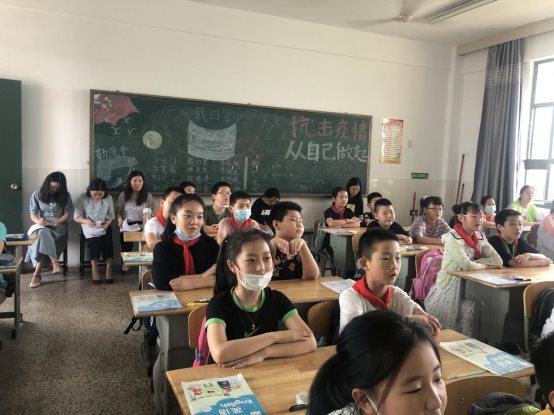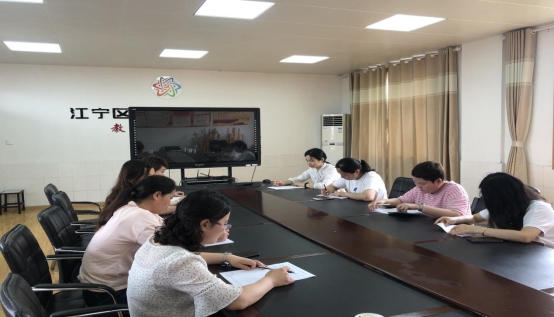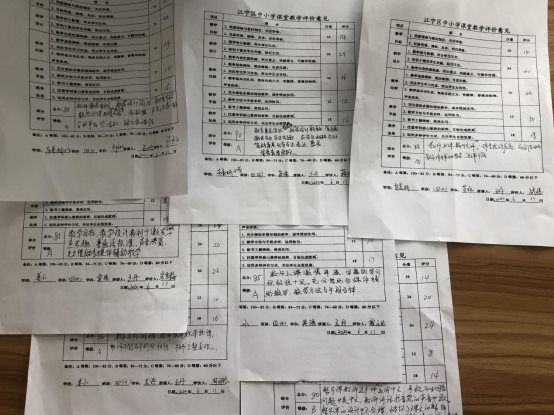2019------2020年度第二学期英语教研组活动
发表日期:2020/6/12 12:03:38 作者:admin 有2715位读者读过
新闻报道:
2020年6月11日,东善桥小学全体英语教师在教研组长翁云花老师的组织下开展了以“四年级语篇阅读方法指导”为主题的研修活动。
首先,由四年级王丹老师执教4B Unit5 Seasons (storytime), 第五单元主要学习四季及其相应天气气候的英语表达,教学贴近生活,学生兴趣很浓。本节课以季节歌曲导入,学生在音乐欣赏中感受四季特征。在课文教学处理中,王老师注重文本的理解,通过各种阅读方法指导、帮助学生逐步理解课文,并通过多种形式的趣味朗读让学生感受四季之美,语言之美。
课后,全体英语教师进行研讨,翁云花、夏道香等老师对王老师执教的《Seasons》进行点评并提出自己宝贵的意见。最后,夏老师指出,在平时的语篇教学过程中应该给学生提供必要的学法指导,帮助学生更好地理解课文。
活动方案:
活动主题 | 4B Unit5 Seasons (storytime)第一课时教学研讨 |
活 动 安 排 | 一、由主备人王丹老师撰写4B Unit5 Seasons (storytime)第一课时一备教案。 二、会议研讨分析第一课时文本,分析四年级学生学情。 三、各英语老师针对一备教案之不足提出自己的修改意见。 四、主备人整合修改意见形成二备教案。 五、主备人进行试上,其他老师听课并进行点评。 |
签到表:

上课、研讨照片:



听课反思:

一备教案:
单元、章、节 | Unit5 Seasons | 教学内容 | Story time | 需课时: 4 课时 | |||
第 1 课时 课型 新授 | |||||||
教学目标 | 1.能听懂、会说、会读、会写season, spring, warm, summer, hot, autumn, cool, winter, cold。 2.能听懂、会说、会读、会写 In spring, it is warm. We go boating。 3.能在老师的指导下有感情地朗读本首诗歌。 4.能表达四季的气候特征及人们相应的活动。 | ||||||
重点难点 | 1.能听懂、会说、会读、会写season, spring, warm, summer, hot, autumn, cool, winter, cold。 2.能听懂、会说、会读、会写 In spring, it is warm. We go boating。 | ||||||
教学方法 | Say and look | 教学辅助手段 | Cards PPT | ||||
教学过程: Step1. Preparation and Situation 1. Greeting. 2. Play a game: Enjoy the song, then give a title. (seasons) Step2. Presentation 1. Learn about the seasons, read the words in different ways. T: How many seasons are there in a year? What are they? 2. Play a game: Listen and say, which season is coming? 3. Show a picture of a park T: What can you see in the park? T: What season is it? (学习Spring 春天,春季) T: How do you feel in spring? (学习warm) T: What can we do in spring? (学习go boating和fly kites) 4. Try to say: In , it is . we fly , we go , we like . (教授句型 It is ...., we .......) 生举例 5. Learn the other three seasons. (1) Discuss in group of four: how do you feel in other three seasons?(学习hot. cool. cold ) (2) Try to say: In , it is . ( act ) (3) Look at the pictures, learn the phrases. T: What can you do in other three seasons? (学习eat ice creams,go swimming, have picnics,go climbing,go skating,make snowmen) 6. Read the poem about the seasons. 7Story time: (1) Listen to the tape and repeat. (2) Enjoy reading: read the poems loudly with emotion. (3) Act the poems. (4) Read the poems together. Step3. Practice.
(1) Look and match (2) 创设情境,实验小学四(2)班的王老师正在为今年的社会实践活动的地点的选择犹豫不决,同学们各抒己见,看看老师能采纳谁的建议? I like . It’s in , It isn’t in . We can see many beautiful . Step4. Summary. Step5. Homework. 1. Read and recite the poem with emotion.有感情地朗读小诗并背诵。2.Choose one season and compose a poem.选择一个季节,并创编一首诗。3.Preview Fun time and Cartoon time.预习Fun time和Cartoon time。 | |||||||
板 书 设 计 | Unit5 Seasons spring warm fly kites/go boating summer hot eat ice creams/ go swimming autumn cool have picnics/ go climbing winter cold make snowmen/ skating | ||||||
二备教案:
4B Unit5 Seasons (Story time) 教案
教学目标:1.能听懂、会说、会读、会写season, spring, warm, summer, hot, autumn, cool, winter, cold。
2.能听懂、会说、会读、会写 In spring, it is warm. We go boating。
3.能在老师的指导下有感情地朗读本首诗歌。
4.能表达四季的气候特征及人们相应的活动。
教学重点:1.能听懂、会说、会读、会写season, spring, warm, summer, hot, autumn, cool, winter, cold。
2.能听懂、会说、会读、会写 In spring, it is warm. We go boating。
教学难点:1.能在老师的指导下有感情地朗读本首诗歌。
2.能表达四季的气候特征及人们相应的活动。
教学准备:PPT.
教学过程:
Step1. Warm up.
1.Greeting.
2.Play a game: Listen and guess.
T: Do you like listening to the music?
T: Yes, I like it too. Now let’s play a game about it. When you listen to the song, if you know the name of the song, please tell me as soon as possible.
T: Well done. All of you did a goo job. (PPT 呈现“春天在哪里”、“宁夏”、“秋天的童话”、“雪绒花”这四首歌名)
3.学习 season
T:What can you find among them?
T:Yes, they are all about seasons. (学习 season)
T: As we all know, there’re seven days in a week. How many seasons are there in a year, do you know?
T: Yes, there’re four. Let’s look at the pictures. How beautiful!
Step2. Presentation.
1. Learn about the seasons.
T: Look at the picture, what can you see in it ?
T: Can you guess which season is it? Now it’s sping.(学习sping) Are you hot? Are you cold?
T: So it’s warm in spring. We can do many interesting things in spring. (学习warm)
T: It is warm, I fly kites. What else can we do in spring? Just use this sentence structure.
(教授句型 It is ...., I .......) 生举例
T: In this season, it isn’t hot, or cold, either. It is yellow. The farmers like this season. Which season is it?
T: Yes, it’s autumn. (学习 autumn) And it’s cool. Here “cool” means 凉爽的.We know it has another meaning is 酷的,漂亮的。We have learned about it last term. Do you remember? What can we do in autumn? 生使用所提供的句型举例。
T: Listen! Can you guess which season is it now? Yes ,it’s summer. ( 学习 autumn)
In summer, it’s very hot. I think., some girls like summer,because they can wear nice skirts, right? What can we do in summer? 生使用所提供的句型举例。
T: White is the popular colour in this season. And it’s the last season of a year. It’s winter.( 学习winter) Sometimes it snows, so the ground turns white. We can make snowmen.( 学习snowmen,并讲解它的原型) 生使用所提供的句型举例。
2. Say a chant
3. Story time
a).Read and complete the form.
T: Just now we talked about the seasons. Our friends are talking about it too. Who are they? Let’s have a look.
T: What are they talking about? Let’s open your books and turn to P32. Read it by yourselves and try to complete the form on exercise paper. Here’s a learning tip for you.
Check the answers.
T:How is the weather in spring?/ What do we do in spring?
b)Read Story time
T:Now it’s your reading time. Read the poem by yourselves. What do you think of the poem? Yes, the poem is beautiful. So we should read it beautifully. Now let’s read it after the tape.
T: Now I’ll give you two minutes to read the poem in a group of four. Let’s compete :which group reads best?
Step3.Consolidation.
T: All of the four seasons are very pretty. But I like summer best. Because It is hot. I eat a lot of fruit. I wear nice skirts.I have a summer vacation. How about you? Which season do you like best? Write it down and try to share with us.
Step4. Homework.
1. Read and recite the poem with emotion.有感情地朗读小诗并背诵。
2.Choose one season and compose a poem.选择一个季节,并创编一首诗。
3.Preview Fun time and Cartoon time.预习Fun time和Cartoon time。
板书设计:
Unit5 Seasons (Story time)
spring warm fly kites/go boating
summer hot eat ice creams/ go swimming
autumn cool have picnics/ go climbing
winter cold make snowmen/ skating
三备教案:
教学目标 | 1. 三会掌握词汇spring,summer,autumn,winter,warm,hot,cold,cool,go boating, go swimming,go climbing,go skating,picnic. 2.听懂、会说、会读It’s...We ... 3.在图片、情景等非语言提示的帮助下,合理描述天气状况、个人爱好等。 | |
教学重点 | 1. 三会掌握词汇spring,summer,autumn,winter,warm,hot,cold,cool,go boating, go swimming,go climbing,go skating,have picnics 2.听懂、会说、会读It’s...We ... 3.在图片、情景等非语言提示的帮助下,合理描述天气状况、个人爱好等。 | |
教学难点 | 在图片、情景等非语言提示的帮助下,正确运用句型。 | |
教学资源 | 1. 学生已有的学习经验:学生在前面的学习中,对几项运动有一定了解。 2. 学生已有的生活经验:学生在生活中对本课所学话题较感兴趣。 3. 学生学习本课时可能出现的错误:部分单词发音有误。将来时与正在进行时混淆。 4. 教学策略:通过创设情境,让学生在相应的语境中学习。 5. 教学准备:单词卡,挂图。 | |
预习作业 | 1. 预习story部分单词。 2.听磁带,跟读这些生词。 | |
学 程 预 设 | 导 航 策 略 | |
A、Warm up (5分钟) 1.Greetings 2.复习swim,skate,boat等词汇,学习swimming,skating,boating B、Pre-reading(8分钟) 学生根据生活经验将四季图片与相符合的感受连线。 根据单词卡,认读单词,并猜测词义。 2.play a game看图片,快速反应季节名称 C.While-reading(12分钟) 学生观察图片,回答相关问题: 1、 Who are they? 2、 What are they doing? 根据以前学过的知识回答。 用相同结构描述夏、秋、冬场景。培养学生的小组合作意识及口语表达能力。 C Post-reading(7分钟) 1.Act it out a, Read fluently
b, Read fluently and beautifully
c, Act it out with emotions
2.Make a dialogue. D Check out(6分钟) 根据所学句型及其他相关图片,自编两组。 E Homework(2分钟) 明确作业要求及下节课教学目标。 | 教师与学生用所学句型相互对话,创设良好的英语学习氛围。 T: What day is it today? T:When can we do these things? 教师出示季节图片让学生认读单词。 通过游戏巩固季节单词。 教师出示春季游玩图片及相关问题: 1、 Who are they? 2、 What are they doing? 引导学生填词 In______, it’s ______. We _______ _______. We go _______.(教授go boating) We like -_______. 分别出示夏、秋、冬活动图片,教授go climbing,go swimming,go skating。 引导学生用动作、表情复述课文内容。 教师巡视学生完成情况。 | |
评价表:

